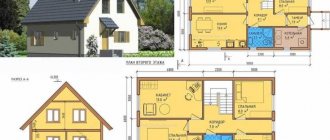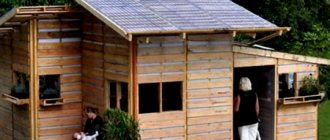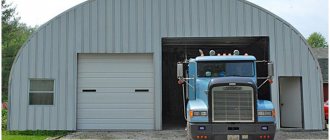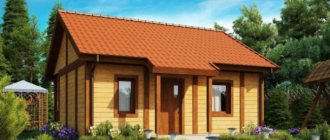What is allowed to build on the site What is a permanent structure Residential building Garage Bathhouse Greenhouse and greenhouse Well Shed Canopy and veranda Gazebo Toilet and cesspool What else is allowed Building a house on your own land can be one of the most pleasant events in life. There are many conditions that need to be taken into account.
You need to understand that you will need professional advice so as not to miss important details and not spoil the work. Timely involvement of specialists in the construction process will help save time, effort and finances.
Professional builders or experienced craftsmen will help determine the best location for the building, select suitable building materials, draw up a project and create a good-quality house or garage.
Before starting construction, it is necessary to draw up a site plan and the correct design of the future building. To do this, you need to know the regulatory requirements and rules, be able to draw up technical documentation and rules for placing individual housing construction buildings on the site.
This is important not only for the comfortable operation of the building, but also for preventing fines from regulatory authorities.
What is allowed to build on the site
The construction of individual housing construction buildings on your personal plot is regulated by the State Town Planning Code. You can build a residential building only if you obtain permission from city or village authorities.
Authorities' permission for individual housing construction is issued for a period of 10 years. Then it is necessary to formalize the commissioning of the building. This process involves the complete completion of all construction work and the preparation of all necessary documentation.
Then the building is registered with the city and checked for compliance with the regulatory requirements of GOST. The owner receives documents on the ownership of his property.
For the construction of a garage, outbuildings, sheds, etc., a permit is not required and ownership is not issued.
If an individual housing construction building does not have a permit, then it is considered an unauthorized construction and is subject to demolition.
Fire safety standards
If the building is more than two floors in height, then a number of fire regulations must be observed in order to put it into operation. For example, it is necessary to provide fire-resistant partitions, equip escape routes and install fire alarms.
Of course, such buildings in dachas are extremely rare, so there is no point in talking about this.
Distances between buildings on the SNT site
All residential buildings are subject to the requirement for indentations, according to the material of the walls and ceilings, as has already been mentioned:
- Buildings made of brick and stone can be 6 meters apart.
- If one of them has wooden floors, the clearance increases to 8 meters.
- Both are partially combustible - 10 meters.
- For wooden structures the distance is 15 meters.
Indentation options are shown in the table above. The distance is calculated from the surfaces of the walls and base. If the building has protruding parts, then the setback is calculated from them or their projection onto the ground.
If there is no central gas supply, a liquefied gas cylinder with a volume of up to 12 liters can be used inside a residential building.
House
Before starting construction on an individual housing construction site, it is necessary to first prepare urban planning documentation.
The list of such documents includes:
- planning scheme;
- master plan of the building;
- detailed plan of all premises.
Construction must be carried out in full compliance with all regulatory documents. When constructing individual housing construction, it is necessary to strictly adhere to the regulatory requirements of GOST regarding the location of communications, electrical supply and installation of gas equipment. If these regulatory rules are violated, the owner will be threatened with fines and other troubles.
A house built on an individual housing construction plot must be intended for only one family. The height of the building cannot exceed 3 floors. The total area of the building should not exceed 1500 square meters. m. The law says that the building must be located separately, and not attached to another house.
Ceiling heights in a country house
It is necessary to clarify that the answer to the question, what is the maximum height of houses in holiday villages, directly affects another important parameter of construction. The comfort of living in the building, as well as some other characteristics, largely depends on it. That is why these restrictions should be considered together.
In this case, we are talking about such a building parameter as the height of the ceilings in a country house. It is obvious that, like any other construction characteristic, a change in this indicator can have both a negative and a positive effect. For example, the advantages of high ceilings are:
- a feeling of spaciousness in the interior;
- creating more comfortable living conditions;
- possibility of using original design solutions, etc.
The disadvantages of high ceilings include:
- increase in construction costs due to greater consumption of materials and labor costs;
- increased costs for heating and lighting of the building.
The current minimum height is:
- for a regular floor - 2.5 m;
- for the basement – 2 m;
- for the attic - 2.3 m.
The choice of the specific parameters of the building always remains with the owner. Moreover, based on the above, it is quite easy to comply with the requirements of the current legislation: the height of a country house should not exceed 10 meters, and its design should have no more than three floors.
Garage
To build a garage for transport on your individual housing construction site, it is not necessary to obtain permission, unless the building is intended for commercial activities. But without registration, the building will not be subject to taxes, but the owners will not have ownership rights to it.
To avoid problems with the law, it is better to legalize the construction of a garage in the relevant authorities. It is especially important to have all the necessary documents for each building when selling a plot of land. An illegal building may affect the value of the land and will simply have to be demolished.
Minimum setbacks from the boundaries of the land plot
The distance from the boundary when building a house depends on the material of its construction. The minimum setback from the boundaries of a land plot on the territory of individual housing construction and SNT is equal, according to SNiP standards, to 3 meters. However, for buildings made of non-combustible building materials in adjacent areas, erected with appropriate floors, it is necessary to comply with fire safety standards - a mandatory 6 meters between them.
Distances to the road and between houses according to SNiP
The minimum distance between houses made of the same materials, but with wooden floors, should be at least 8 meters. Houses and buildings made from fire-hazardous building materials are located at a distance of 12 m.
Bath
The decision to register a bathhouse in the state register depends on whether the building has a permanent foundation, what size the bathhouse building will be, and on the characteristics of the site.
For a small rural bathhouse, which is installed directly on the ground and can be moved to another location, a building permit does not need to be issued. But for a large bath complex with a swimming pool and sauna, a massage room and a winter garden, it is better to issue permitting documentation and calmly enjoy the healing water procedures.
What standards regulate the issue?
The primary consideration of fundamental rules does not mean that there are no other official guidelines and restrictions. The realities of modern existence provide for the need to fulfill the points specified in other documents, taking into account the risks from sources of comfort, lighting or heat.
House
Fire regulations requiring safe distances eliminate the possibility of fire from potential hazard sources. The presence of the necessary setback from power lines, above-ground and underground, and gas pipelines not only helps to avoid their damage when digging a trench during construction.
This is also concern for the life and health of people who will live or work in the constructed building. When building a residential building, the developer needs to take into account the following regulatory documents:
- SNiP - developed back in Soviet times, and subsequently repeatedly edited and supplemented to bring them into line with modern legislative realities;
- SanPiN – epidemiological and sanitary safety standards, derived through scientific research and ensuring the absence of environmental contamination and the safety of people from possible infection;
- fire-fighting distances regulated by Federal Law No. 123 are measures aimed at preventing fires in buildings from potentially dangerous objects. The Federal Law specifies at what distance the construction of residential buildings and household structures is allowed;
- The Town Planning Code specifies the necessary distancing of real estate from public buildings, garages, educational and medical institutions, maximum distances from the road;
- PZZ – rules of land use and development;
- The Code of Administrative Offenses provides for a whole system of sanctions: fines and penalties for violating regulations in documents equivalent to legislation.
After building a house
Supervisory authorities help to avoid common mistakes in construction in urban and rural areas.
They are the ones who determine what the required distances should be based on existing laws, checking the plans of developers, making adjustments if errors are made in the design. They also approve standards for how different types of buildings should be placed.
Greenhouse and greenhouse
Small greenhouses and greenhouses that are built for oneself without a capital foundation are allowed to be built on individual housing construction without obtaining permits. If the greenhouse complex is planned to be used for commercial purposes, then documentation will still have to be completed in order to avoid penalties and other troubles from inspection authorities.
Which banks provide mortgages for construction?
“In almost all regions there are large banks that issue mortgage loans for these purposes,” explains real estate investment expert, head of a real estate agency Andrei Mozol. ― Among the largest are Sberbank, RosBank, VTB, Dom.RF. Conditions vary from bank to bank; they need to be clarified with the financial institution. But there are also general ones: the rate is from 4.6% per annum, the down payment is from 0%, the term is up to 30 years.”
According to the expert, the most favorable conditions offered by banking organizations may turn out to be a marketing ploy. For example, subject to lending at 5%, the bank can limit the period of use of loan funds to five years, and if the term increases, it can increase both the rate and the amount of the down payment.
Therefore, it is necessary to evaluate the terms of a mortgage for building a house taking into account weighted factors: you should initially decide on a “comfortable” monthly payment amount, the possibility of paying a down payment, and only then select programs that meet your expectations and financial capabilities.
pexels.com/
Well
For shallow wells that will be used on the individual housing construction site for household needs or for irrigation, it is not necessary to obtain permits.
The law does not prohibit free access to upper aquifers that are not mineral resources. This design will be inexpensive, but it will not provide much water.
For deeper and more functional wells or stations, it is necessary to issue permits and hire specialists for drilling. But the well will provide clean, healing water for a long time, meeting all consumer and household needs.
Neighbor violated building codes - where to complain?
There are cases when neighbors place their buildings close to the fence, snow rolls off their roofs onto the property, and the shadow blocks the light from the plants. How to deal with this? First, you should try to resolve disagreements with your neighbors amicably. Explain what exactly is stopping you and ask to eliminate the shortcomings. But, alas, sometimes it doesn’t work out that way. Then there are two options:
- Filing a complaint with local authorities regarding non-compliance with urban planning standards. If, as a result of such an appeal, the problem cannot be solved, the most effective method remains - the court.
- Statement of claim to the judicial authorities. However, when filing a complaint, keep in mind that neighbors may follow the principle and file a counterclaim - complaining about the location of your buildings.
In addition, court costs and expenses have not been waived. You must be prepared to spend money and time to defend your rights. Many standards are advisory in nature. Before going to court to protect your rights, you should competently draw up a statement of claim, and to do this, seek the help of a lawyer. All complaints must be substantiated and documented.
Shed on a private housing construction site
A small shed built on individual housing construction without a solid foundation does not require documentation. But if the building is large in size and built on a solid foundation, then it is better to carry out full registration of the building and obtain permits. This is especially important when selling a plot, as it can significantly increase the value of the land.
List of documents
Since the area covered by the regulations is huge, from the start of construction to commissioning, it is regulated by several dozen regulations.
In order for the developer to easily navigate this package of regulations, specialists have prepared a Code of Rules (SP) for certain objects. In 2016, SP No. 55.13330 was issued for residential households, and similar sets of rules have been prepared for other construction projects.
It is important to consider the following standards :
GOST 27751-2014;- GOST 30494-2011;
- GOST R 53780-2010;
- SP 1.13130.2012;
- SP 4.13130.2013;
- SP 7.13130.2013;
- SP 30.13330.2016;
- SP 32.13330.2012;
- SP 256.1325800.2016;
- SanPiN 2.1.2.2645-10;
- SP 11-106-97;
- VSN 59-88;
- RDS 30-201-98;
- SanPiN 2.1.4.027-95.
Such standards have been updated with recent changes in legislation to increase the safety of people in buildings and protect property in accordance with the requirements :
- according to technical safety regulations;
- sanitary and epidemiological standards;
- fire safety and energy efficiency.
This Code of Rules must be applied when performing design, research, and construction work for houses with no more than three storeys.
They separately highlight sections on obtaining technical specifications for connecting engineering and transport infrastructure, rules for the location of sites and the placement of objects within the boundaries of the land plot, taking into account the requirements of fire and sanitary and epidemiological safety for living conditions.
There is also a separate section in connection with which the developer, during the construction process, must carry out the necessary set of measures to protect the environment from threats that may arise during the construction process or during the operation of the facility, for example, when installing utility networks or placing cesspools.
Shed and veranda on your own site
When building a light wood shed or a summer veranda for a pleasant rest in the shade, you can do without paperwork. Moreover, such buildings are not permanent buildings and can be demolished at any time at the request of the owners. But if the veranda is attached to the wall of the house and is its continuation, then it is better to design it as an extension. At the same time, the useful area of the room will increase, and the cost of the building will increase significantly.
Conditions for the construction of a second residential building on a land plot
It is very important to maintain the correct distances when building a second household on the site. There is no direct prohibition on the construction of such an object by law, however, when legalizing the structure, problems may arise due to violation of the minimum gaps.
The standards for the construction of a second home are related to the maximum permitted percentage of development , as well as the smallest gaps between the house and the boundary of the land plot. These data are determined by the city municipality, so these indicators may differ significantly for each locality.
In order to find these readings, you need to go to the website Rules for land use and development of a specific area, for example, the Moscow region. The archive contains a Town Planning Plan or Zoning Map, the Rules indicate the maximum percentage of development of 40% and the setback from each household to the boundaries of the land plot is 3 m.
For land of 6 acres, two houses (without other buildings) should have an area of no more than: 600X0.4:2 = 120 m2 , and the distance between them should be 6 m. If additional utility facilities are built, the area of the houses should be reduced accordingly.
Toilet and cesspool
A rustic toilet with a simple pit cesspool is not a property. It does not need to be registered or formalized in the registry. But if the toilet is built on a solid foundation, has modern communications and water supply, a laundry complex and other functions, you need to register the building and obtain all rights to it.
This also applies to the construction of commercial toilets that will serve a large volume of people and generate income for their owner.
Sanitary standards and requirements
The requirements for distances from the fence listed earlier also apply to sanitary ones, but they are not the only ones. This also includes standards for the distribution of objects across the site and their distance from each other.
- If the cellar is located outside the residential building, a distance of 12 meters must be maintained from it to the septic tank.
- The norms for the construction of a bathhouse on a garden plot require that it be removed 8 meters from the house.
- The same gap is left from the toilet and composting device to the well. This is necessary so that dirty wastewater is not transferred to drinking water by groundwater (you can find out more about the distance from the house to the septic tank on our website).
Location of buildings on a summer cottage for gardening - basic indentations according to sanitary rules
- A distance of 12 meters is also left from the house to the outbuilding.
- A cellar can be built under the house (the layout of a modern house with a basement is presented in the article) - its maximum height should be 2.2 meters. It is prohibited to allocate space under barns where livestock are kept for a cellar.
Is it necessary to register ownership of a greenhouse or toilet if they are placed on a solid foundation? What should you do if the house you built is very close to your neighbor’s property? Will they force it to be demolished? How to register an old land plot?
These and other relevant questions for lovers of country life were asked on the hotline with readers of Rossiyskaya Gazeta. They were answered by the General Director of the Moscow Regional BTI Roman Larin
and expert of the Federal Cadastral Chamber of Rosreestr Nadezhda Leshchenko.
So what to do with greenhouses? There is a lot of directly opposite advice on the Internet. Is it still necessary or not to register them as property?
Roman Larin: It all depends on the purpose of the site. If the land is intended for vegetable gardening, then the construction of capital construction projects is not allowed on such plots. This means that all outbuildings (sheds, bathhouses, greenhouses, sheds, cellars, wells and other structures) cannot be erected as capital ones - on a solid foundation.
If you have not registered your dacha buildings as property, it will be difficult to sell, donate, or rent them out, and problems will arise for your heirs as well.
But garden plots can accommodate capital outbuildings that are firmly connected to the ground, that is, objects that cannot be moved without compromising their purpose. Rights to such objects are subject to registration.
That is, if such greenhouses appear on garden plots, will they be forced to demolish them? And for gardens, you have to register. It's clear. But what about a brick toilet if it is combined with a storage room?
Roman Larin: The answer is the same.
Reader from the Moscow region. In the Solnechnogorsk region in SNT, he “has a hut, a 6x6 meter beam on cement blocks. With an attic." 30 years without registration. Used only in summer. Do you need to register?
Roman Larin: Here are all the signs of a garden house, which is used for temporary residence. The garden house is subject to registration. But please note: the procedure is of a declarative nature.
As, by the way, with the stone toilet.
At the same time, you must understand: if you own a property, it is easier to sell it, donate it, or rent it out. Heirs will also have fewer problems with further use.
Question from Vyacheslav Nikolaevich Martynov from Penza. On his property, he has had an omshanik (room for breeding bees) on the foundation for a long time. Double decker. Now he is adding a kitchenette. Register?
Nadezhda Leshchenko: The situation, frankly speaking, is not very standard. As far as we understand from the reader’s explanations, his plot is owned by a gardening partnership.
At first he wanted to keep bees there, but for some reason this did not work out. Now he is constructing some kind of building for seasonal living.
That is, it will be something similar to a garden house, intended not for permanent, but for temporary residence. But the building is built on a permanent foundation, that is, the structure is firmly connected to the ground; it cannot be moved from place to place without damaging its design features. And such buildings are subject to registration.
It's better to be friends with your neighbors
What should Vyacheslav Nikolaevich do for this?
Nadezhda Leshchenko: First of all, call a cadastral engineer and conclude an agreement with him on the preparation of a technical plan for a garden house.
He will determine exactly what kind of building it is, draw up a technical plan, which then needs to be submitted to Rosreestr. The application and necessary documents can be submitted either in person or sent by mail, or through the government services portal or the official website of Rosreestr.
According to the new law, if someone does not pay membership fees for more than two months, he can be expelled from the gardening partnership by decision of the general meeting
But the reader notes that he may have problems with his neighbors. As we understood, it was due to the fact that his building was too close to their site. And indentations must be maintained - at least three meters. What should I do?
Nadezhda Leshchenko: The easiest way here is to agree with the neighbors that they have no complaints.
But if the neighbors contact the land or building supervision authorities, then problems may arise, to the point where it will be necessary to reduce the parameters of the building. Conclusion: it’s more profitable to be friends with your neighbors!
Waiting for the dacha amnesty
Without a dacha amnesty according to the notification procedure for construction and registration of real estate, this building can no longer be registered as property?
Nadezhda Leshchenko: If he has already built it, then putting the building on the cadastral register and registering ownership of it at the moment is only possible on the basis of a notice of completion of construction or a court decision.
The dacha amnesty, in fact, ended ahead of schedule on March 1, 2019, when the transition period for the new rules that introduced amendments to the Town Planning Code of August 4, 2022 ended. But a bill has already been submitted to the State Duma to extend the dacha amnesty until March 1, 2022. How many houses and dachas are not registered as property today?
Nadezhda Leshchenko: Neither Rosreestr nor the Cadastral Chamber has such data. Local authorities should have information about how many unregistered individual houses and dachas there are.
Because the Unified State Register of Real Estate (USRN) contains information only about real estate objects registered for cadastral registration and registered rights to them. Since 2006, about 13 million property rights have been registered using a simplified procedure.
And the procedure for registering property, as we have already said, is of a declarative nature. The citizen decided to become the owner, came with an application to Rosreestr, his right to the property was registered in the Unified State Register of Real Estate.
Roman Larin: In the Moscow region, in particular, the program to involve objects in the tax turnover that we have not registered in the cadastral register and have not registered rights to them began in 2016. Over three years, we have identified about 900 thousand such objects. Of these, about 500 thousand have already been registered in accordance with all the rules.
But the notification nature of construction and registration of real estate, which was introduced by amendments to the Town Planning Code, presupposes that a person is given 10 years to build an individual residential or garden house.
He must meet these deadlines and submit a notice of completion of construction. If everything is built according to the rules, local governments themselves submit documents for registration to Rosreestr. That is, with such rules it is no longer possible to avoid registering real estate.
But at the same time, the state identifies unregistered objects - unauthorized construction.
Roman Larin: Reveals. But we can only inform people what advantages property rights provide.
It’s time to close the “border” issue
Let's clarify: what are the main difficulties that may arise with old houses and buildings without the extension of the dacha amnesty?
Roman Larin: First of all, as we have already said, these are violations of indentations. That is, houses were previously built without taking into account how close they were to the boundaries of the land plot.
Quite often the porch of the house practically looks into the fence of the neighboring plot. Special conditions for the use of territories were also not observed, for example, there are residential buildings that fall within the area of airports, power lines, and environmental zones.
There are violations regarding the types of permitted use of land plots. In a number of cases, the parameters of the built houses exceed the norms established by the Town Planning Code: no more than 3 above-ground floors and no more than 20 meters in height. In all these cases, it will be impossible to register ownership of the house.
What other buildings, besides houses and dachas, are covered by the dacha amnesty?
Roman Larin: For example, garages, outbuildings with signs of capital construction, not intended for commercial activities.
Question from a reader from Bashkortostan. There is an unfinished house on a plot leased for individual housing construction. He wants to register ownership of the plot, but he is refused on the grounds that construction must first be completed. Is this legal?
Roman Larin: Everything is correct. In accordance with current legislation, the right to acquire ownership of land plots under lease rights arises only from the owners of buildings, structures, structures located on this site.
Accordingly, it is necessary to first complete construction and register the title to the house. Only after following these procedures will a citizen receive a pre-emptive right to purchase this land plot. Until construction is completed, the land cannot be purchased. You can only extend the lease agreement.
The reader’s house is currently under construction. Will it be possible to apply for it under the dacha amnesty if it is extended?
Roman Larin: If a plot of land was provided for individual housing construction (IHC) or personal subsidiary plot (LPH) within the boundaries of populated areas, then for the construction of a residential building it was necessary to obtain a construction permit.
If a plot of land was provided for gardening or summer cottage farming, then permits were not required for the construction of country houses and garden houses. The right to such objects (on SNT/DNT lands) was registered in a simplified manner according to a technical plan drawn up on the basis of a declaration and title documents for the land.
Nadezhda Leshchenko: And one more thing. If the house is on the lands of individual housing construction or private household plots, then regardless of whether the dacha amnesty is extended or not, it will be possible to register ownership either on the basis of a construction permit and title documents for the site, or a notice of completion of construction.
As for residential and garden houses in SNT, when extending the amnesty, when the house is completed, it is necessary to invite a cadastral engineer who will prepare a technical plan based on the declaration. Next, contact Rosreestr yourself. If the amnesty is not extended, then it will also be necessary to submit a technical plan with notification of the completion of construction to local governments, which will independently direct them to register property rights.
Only through court
Mikhail from the Samara region describes such a situation. After the death of his parents, he did not find any title documents for the land plot in the gardening partnership. What should he do to register the plot for himself?
Roman Larin: Now only through the court. First of all, we recommend submitting a request to the territorial archive and requesting a copy of the land title documents.
You can also contact Rosreestr and request information from the State Data Fund. It is more convenient to submit requests through the MFC at the location of the object. This information will serve as evidence when going to court to recognize your rights.
Question from Igor from the Vladimir region. He has a house on 6 acres in the city. Land for individual housing construction was allocated in the 50-60s of the last century for lifelong use. The property has not been registered. How can we get all this legal now?
Nadezhda Leshchenko: It should be noted that in relation to land plots, the dacha amnesty does not have an expiration date. If the reader has title documents for a land plot, then you just need to apply for registration of ownership of it. And if there are no documents, then ownership will also have to be established in court.
Question from Irina from the Moscow region. She owns half the plot. And the second half goes to the husband of the deceased sister. Irina ordered land surveying of the entire site. It was made. But Irina must submit land surveying documents to Rosreestr together with the second owner. But he refuses to go to Rosreestr. Doesn't use the site. What do you advise?
Roman Larin: Again, a situation that can only be resolved in court. In this case, there must be an expression of the will of both parties. If one of the owners avoids going to Rosreestr, then the court decision can replace the statement of the owner who is avoiding registration. That is, Irina can come to Rosreestr with a court decision and submit documents for registration.
How does a technical plan differ from a boundary plan?
Remove me from the register!
Tamara Shetikova once registered her buildings. And now he’s wondering how to exclude dilapidated barns and greenhouses standing on supports from the Unified State Register of Real Estate? After all, they are not worth the tax she pays for them.
Roman Larin: It is possible to exclude objects from the Unified State Register of Real Estate, the right to which is registered in a declarative manner, only in the event of destruction or destruction of the objects.
To record the termination of the existence of objects, you need to call a cadastral engineer. He will draw up an inspection report for the specified objects. This is a document confirming the termination of the existence of an object. This will be the basis for termination of the right to the Unified State Register and removal from cadastral registration.
Here's another similar situation. On the land plot, which is registered as a property, there is a dilapidated house built in 1928. It is registered as a property, but our reader wants to deregister it and use it as an outbuilding. Is this possible? She has a new house, but she cannot register ownership because the local architecture department requires the old house to be demolished.
Roman Larin: In this case, there is no application procedure for deregistering and registering the rights of a residential building registered as a property and transferring it to the status of an outbuilding. The deregistration procedure is provided only in connection with the cessation of the existence of an object. To confirm the existence of the house, you will need to order a house inspection report from a cadastral engineer. But first you really need to demolish the house.
What, you can’t have two houses?
Roman Larin: Theoretically, it is possible to build two houses on one plot of land. But only in compliance with the norms of land and town planning legislation, building codes and regulations, in particular, the area of the land plot should allow such construction. In this case, most likely, the land plot does not physically allow the construction of a second residential building on it, since the requirements will not be met necessary setbacks from boundaries, other norms and regulations (for example, fire safety). That is why the applicant is denied approval for such construction and is recommended to demolish the first house. But you can try to recognize the right to a second home in court.
Vladimir Vasilyevich Khabarov from Ryazan is the chairman of the Vesna horticultural non-profit partnership. When public roads were registered as the property of the partnership, it was necessary to go through land surveying and clarify the boundaries: “I did this, submitted the documents to the MFC “My Documents.” But I was informed that only the municipality can clarify the boundaries. I contacted the municipality, but they said that they do not deal with this. As a result, we were unable to privatize land. And now we cannot register common ownership. What to do?"
Nadezhda Leshchenko: If by decision of the general meeting of members of the partnership it is Vladimir Vasilyevich who is authorized to resolve issues of registration and cadastral registration of public land, then I see no reason to suspend registration.
Each territorial body of Rosreestr has an appeal commission. It is advisable to contact this commission. This must be done within 30 days from the date of the decision to suspend registration and registration activities.
Roman Larin: You can take with you a letter from the local government where they refused you. The decision made by the appeal commission is the basis for changing the decision of the state registrar.
Bill
No need to pay
“Currently, the Ministry of Economic Development of Russia,” recalled Roman Larin, “is developing a bill that clarifies the criteria for classifying objects as immovable or movable things. According to the bill, auxiliary buildings: sheds, greenhouses, etc. will be considered improvements to the land plot or the main facility - for example, a residential building. And previously registered buildings can be excluded from the Unified State Register of Real Estate in a simplified manner at the request of the copyright holder. Amendments to the Ministry of Economic Development provide for the exclusion from the tax base of buildings that are improvements to a land plot.”
Land question
Our reader inherited a plot of land in the village, but she doesn’t have time to deal with it yet. The girl asks: won’t it be taken away if you don’t use it for a long time?
Nadezhda Leshchenko: Indeed, the Land Code contains a provision on the termination of the right to a land plot. If a land plot granted with the right of permanent (indefinite) use or lifelong inheritable possession is not used for 3 years, then it may be withdrawn. We recommend that the reader still start registering the rights to what she inherited. If you don’t have time to do this personally, then you can issue a power of attorney to relatives or one of your friends whom the person trusts.
What else can the land be confiscated for?
Roman Larin: If the site is not used for its intended purpose. For example, a plot of land was allocated for farming, and a store was built there. Or the activity organized on the site harms the environment. Let's say a car wash is open.
Look at the situation in SNT with Sergei Borovikov. Half of all plots have not been used for 25 years, and the owners are unknown. And all maintenance costs are borne by 60 plot owners. Most of them are pensioners. How to remove the owners of abandoned plots from members of the partnership?
Roman Larin: According to the new law on gardening and vegetable farming, which came into force this year, if SNT members do not pay membership fees for more than two months, they can be expelled from the partnership.
This is done through a decision of the general meeting. If a land plot, as we have already said, has not been used for its intended purpose for more than three years, it is necessary to contact the local government authorities, which can initiate the procedure for the seizure of such a plot. Seized land plots due to non-use for their intended purpose or use in violation of the law are subject to sale at public auction.
Question from the Sverdlovsk region. A resident bought a plot of land in 2022 and began building a house. Agricultural land. Almost completed, but when submitting a notification to the administration, I was refused registration of a residential building, since local land use and development rules do not provide for the construction of residential buildings on such land from March 1, 2022. Although before this everything was registered through the MFC without problems. What should I do?
Nadezhda Leshchenko: If local rules do not provide for the placement of residential buildings on such land plots, but this was possible before March 1, 2022 (as follows from the reader’s message), then, I believe, the reader has the right to challenge the land use and development rules in court.
The reader wants to buy a plot for building a country house and farming for his own (non-commercial) needs. What kind of area should this be?
Nadezhda Leshchenko: The land plot must be located within the boundaries of the populated area. Category of land - land of settlements. The type of permitted use of the land plot must be either for individual housing construction (individual housing construction) or for private household plots (personal subsidiary plots).
On individual housing construction lands it is possible to: place a residential building (a separate building with no more than three above-ground floors, no more than twenty meters in height, which consists of rooms and auxiliary premises intended for living). On such lands it is allowed to grow agricultural crops, place individual garages and outbuildings. On the lands of private household plots (homestead land), you can build a residential building, grow agricultural products, place garages and other auxiliary structures, and keep farm animals.
Is the land amnesty, unlike the dacha amnesty, still valid? What do you need to do to use it?
Roman Larin: Yes, and applies to lands allocated before October 30, 2001 (the date of entry into force of the Land Code of the Russian Federation) for individual housing construction, personal farming, gardening and truck farming, individual garage construction.
In order to obtain ownership of such plots, you need to have in hand the documents on the basis of which the land was allocated at one time. For example, this could be an extract from the household register, a pink or blue certificate, an extract from the decree on the provision of a land plot. In relation to individual housing construction, the land amnesty is valid indefinitely. As for plots in gardening and vegetable farming partnerships, the amnesty is valid until December 31, 2022. In this case, the plot must be distributed to the summer resident by decision of the general meeting.
Mortgage conditions for construction in 2022
The borrowing limit is determined by the bank's program. If a financial organization offers its own “product,” the limit can reach up to 120 million rubles. If the borrower expects to receive a mortgage for construction with government support, the limits will be more modest.
This year there are three state programs under which you can request funds for the construction of a private house at a small percentage:
- Family mortgage . The rate on it is 6%, the size of the down payment is at least 15%, you can borrow money for a period of up to 30 years and in an amount of up to 12 million rubles.
- Rural mortgage . Under this program, you can get a loan at a very favorable rate of up to 3%, but you can only build on land in rural areas. The contribution under the program is from 10%, and the amount is up to 5 million rubles.
- Far Eastern mortgage . The program is designed for young families in the Far East regions who want to improve their living conditions, and for young Russians who are ready to move to the region to live and work here. The conditions are more than loyal: lending at 2.5% and with a down payment of 15%. You can expect to receive up to 5 million rubles.
Banks’ own programs differ from targeted programs with state support. Thus, VTB is ready to provide a mortgage for the construction of a house from 9.3%, but only on the condition that the land plot is located in a cottage village.
Sber has two lending options: regular and preferential. In the first case, the rate is from 9.2%, while the down payment is at least 25%, and the loan is secured by a residential premises or land plot. At the same time, the bank is ready to provide no more than 75% of the funds required for construction. A preferential mortgage for the construction of a country house provides a lower rate - from 6%, but it is provided only if the borrower is ready to enter into an agreement with a developer from a list approved by the bank.
RosBank will not approve the application if the site is not registered as the property, but is rented. Dom.RF does not provide such a loan in some republics of the North Caucasus.
You need to clarify the conditions at a bank branch, on the website of a financial institution, or using online portals that provide selections of loan products and their comparisons.
pexels.com/











